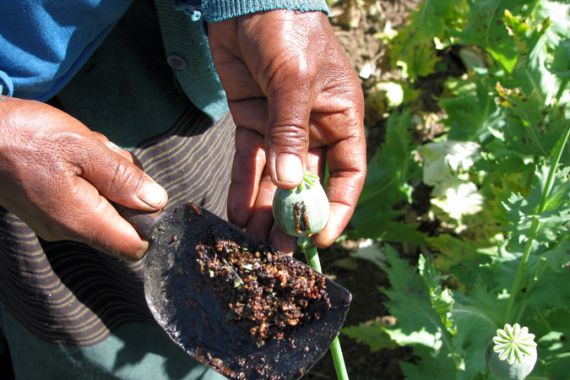Opium production ‘on the rise in SE Asia’
Higher poppy output in Myanmar seen for a sixth successive year, driven probably by demand for opiates, UN study finds.

The cultivation of illegal opium has increased in Myanmar for a sixth successive year, driven in part by a rising demand for heroin across Asia, according to the United Nations.
Myanmar is the world’s second-largest producer of opium after Afghanistan, accounting for nearly 25 per cent of global poppy production, according to a report released by the UN on Wednesday.
Keep reading
list of 4 itemsWorld’s coral reefs face global bleaching crisis
Why is Germany maintaining economic ties with China?
Australia’s Great Barrier Reef suffers worst bleaching on record
The surge comes despite a government campaign to eradicate the crop from the Southeast Asian nation.
The rise in output of opium, the raw ingredient used to make heroin, was documented in the latest annual survey by the UN Office on Drugs and Crime.
The report said farmland under opium cultivation rose by 17 per cent this year, up from about nearly 40,000 hectares in 2011 to 51,000 hectares in 2012.
Myanmar’s illegal crop is farmed mostly in Kachin and Shan states.
The two areas, located along the country’s borders with China, Thailand and Laos, have been plagued by fighting between armed groups and the military.
Poppy is highly lucrative for impoverished farmers in need of cash, and the fact it can fetch as much as 19 times that of rice poses a huge challenge to government efforts to eradicate it.
Higher output
The estimated 690 metric tonnes produced in Myanmar in 2012 was valued at roughly $359m, the report said.
That output was up from an estimated 610 metric tonnes last year.
“One probable factor behind the resurgence in opium production in Southeast Asia is the demand for opiates, both locally and in the region in general,” the report said.
The vast majority of consumers are in China, with opiate users in East Asia and the Pacific Ocean region accounting for about one quarter of the world’s total.
Gary Lewis, of the UN Office on Drugs and Crime, says the Chinese market for heroin has increased by 20 per cent in the last 10 years.
“On top of that you’ve got a situation where farmers are operating in desperate conditions on the ground and they’re looking to provide a cash income to support their families”, he told Al Jazeera from Bangkok on Wednesday.
|
The swath of Southeast Asia where the borders of Myanmar, Thailand and Laos meet is known as the Golden Triangle.
It produced more than half of the world’s opium in 1990 and one third in 1998.
In Laos, the amount of land used for growing rose by 66 per cent in the last year alone.
It is now able to produce about 41 tonnes of opium, worth up to $72m.
Thailand’s output has fallen very slightly in the last year. It produces just three tonnes of opium – worth four million dollars at last year’s prices.
And it is the only country of the three which operates its own monitoring system.
In 1999, Myanmar set out to become opium-free by 2014.
That campaign had made considerable strides, but production has risen every year since 2006 as demand and prices grew.
Citing government figures, the report said the government had eradicated poppies on about 24,000 hectares of land in 2012, compared to 7,000 hectares the previous year.
The 236 per cent increase “is a significant increase on the area reported as eradicated in previous years”.
